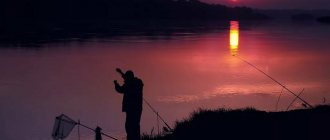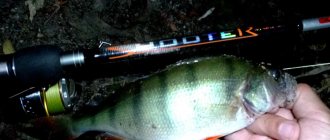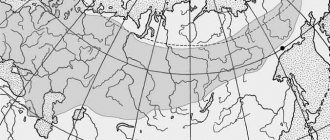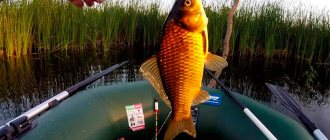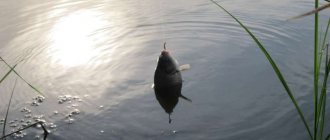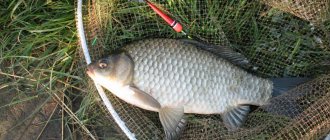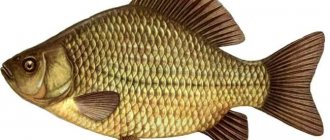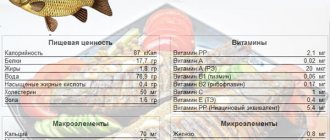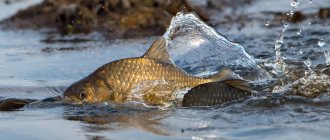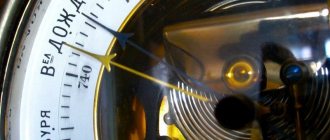Goldfish
Catching crucian carp is always accompanied by excitement, because this fish is smart, careful and picky in terms of bait. To catch it, you need to have some knowledge: behavioral characteristics, know its probable habitat, favorite baits of a particular body of water, etc.
Description and behavior characteristics
Crucian carp (Carassius) is a genus of fish from the carp family. His body is tall, slightly flattened on the sides, and his back is thick. As we know, there are two types: silver, gold.
The scales of both species are large, the fin on the back is elongated, and the tail is notched. Body size and weight vary greatly, for example, in the Upper Volga and Siberia they are larger:
- gold is always larger - up to 60 cm or more, weight from 2-5 kg;
- silver - up to 40 cm, weight up to 0.5-2 kg.
Golden carp
In smaller rivers and lakes, the usual dimensions are: 10-25 cm, weight up to 500-700 g. They live up to 12 years, sexual maturity occurs at 3-4 years of age. They spawn twice in the spring, laying eggs on vegetation. They feed on: insects, algae, zooplankton, zoobenthos, detritus, small invertebrates.
It doesn’t rush at the hook, it first licks the bait, sniffs it, tastes it, but if it accidentally pricks itself with a hook, it often immediately spits it out and swims away.
The type of reservoir affects habits, fishing characteristics and behavior:
- If it is dominant, or the only species , it will greedily and boldly peck at various baits, but the sizes will be small, because they quickly degenerate into dwarf forms.
- If, in addition to it, other “allied” breeds live : carp, tench, rudd, etc. Then the size will be large, and they will peck at both plant and animal bait.
- In the vicinity of a minnow or rotan , it will be possible to profit from large crucian carp, but only with plant bait.
- If there are predatory species in the reservoir , then you can count on a trophy specimen.
In what wind does crucian carp bite better in summer?
Wind, as one of the bite factors, is expressed in the direction and strength of the air.
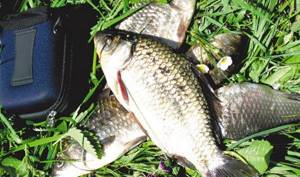
Direction directly affects wind temperature:
- A warm southern wind, combined with low air and water temperatures, will have a beneficial effect on fishing, where the fish will feel comfortable and actively search for food.
- The northern cold wind can have a positive effect only if the temperature is consistently high for a long time (low oxygen levels in the water cause the fish to become more active).
As for the strength of the wind, the most favorable is considered to be the force of the flow that creates ripples on the surface of the water surface. This is a kind of camouflage for the fisherman, and the object of fishing is completely unaware of what is happening on the shore.
With a strong air flow, large waves are created that scare away prey, while the vibrations of the bait increase sharply, which also alarms the crucian carp.
A qualitative and quantitative catch is possible after the strong wind calms down and various larvae appear on the shores washed away by the waves - the favorite delicacy of crucian carp.
Here we have already covered the question in what wind the fish do not bite.
Fishing calendar by fishing season
Winter - the most unpredictable, in some reservoirs it is caught very well, in others only at the beginning or end of freeze-up, in some places it does not take the bait at all. This is more connected with the peculiar characteristics of each specific body of water. Small fish burrow into the mud somewhere in December, larger fish can still move. The most productive biting time: early December - January. With the onset of stable frosts, it lies at the bottom. This means you need to look for it near coastal thickets, at changes in depth, where there are predatory fish. With warming, and before the last ice melts, the bite almost stops.
The optimal weather for winter hunting is sunny days.In bad weather, it immediately goes to the depths, and there is no way to lure it out of there.
- Spring - it’s just an ideal time for fishing; with a sharp warming up to 10 ºC it becomes quite active, and at 10-15 ºC the incessant biting will begin. The bite is greatly influenced at this time by the unsteady water temperature. Before new vegetation appears, all fish clearly divide their habitats among themselves. If only small crucian carp are hooked, look for another place; only large ones will probably be caught there.
In spring, the water has not warmed up completely, so the fish stay in the lower layers.Only for feeding it swims to coastal areas overgrown with pondweed, reeds, and reeds. During the pre-spawning period and after it is an ideal time for hunting, you can see a real zhor.
- Summer - stable time, it is in the summer that you can catch a big trophy. Just don’t discount weather conditions; if there is prolonged bad weather: gloomy weather, thunderstorms, rains, activity decreases. At the beginning of summer, spawning continues, so fishing may not be particularly productive. Crucian carp spawns 2 times during the summer, you need not to miss the moments of real gluttony: before and after spawning.
Fishing can only be successful if the time and place are chosen correctly. You can find it: along the coastline, where trees grow, near all kinds of thickets.He is looking for at least some shade and hides throughout the daylight hours; good bites can only be there. You should not look for it in reservoirs that are beginning to “bloom”; there is not enough oxygen for it.
- Autumn — the water temperature drops, summer food becomes insufficient. The fish moves away from the shore, it is still comfortable and warm there. In early autumn, if the weather is good, it will sometimes return to summer feeding in shallow water. With increasing cold weather, fish in small reservoirs begin to move, find other places with a muddy bottom and hard terrain and begin to settle in them. With the onset of stable frosts, it buries itself in silt, and in large water areas it lies far from the shore, in bottom holes. And it doesn’t react at all to any attachments. But if the fisherman can determine their location, then he will be rewarded with an excellent catch, right up to the freeze-up. The catch may be successful:
- in wet weather with drizzling rain;
- strong wind, rain, snowfall;
- before the weather changes.
What does the start of crucian carp biting depend on?
The crucian carp actively begins to bite when the water in the reservoir warms up enough. If a river, lake or pond is shallow, then the crucian carp will start biting in it earlier than in a deep one, since the water there will warm up earlier. It has been noticed that active biting begins when the water temperature is maintained for a week from 10 to 12 0C.
Spawning
Spawning of crucian carp can begin in late April and last until early June.
Crucian carp begins its first spawning when it reaches the age of 3-4 years. During spawning, the crucian carp does not bite and becomes lethargic and inactive.
The start of this process depends on:
- water heating temperature. Silver crucian carp begins to spawn when it reaches 130C, golden carp is more thermophilic - from 170C.
- climate of the area - the colder the air, the later spawning will begin and slower
- the size of the reservoir - the larger the reservoir, the slower it warms up, the later the spawning process will begin and the longer it will be
- from the way of life of crucian carp
- depending on the type of reservoir (river, lake, swamp, peat bog, etc.)
In the spring, river crucian carp migrate in flocks to spawn up the river and look for places where there are spills and dams. In summer it returns to its permanent habitat. Therefore, catch it in the river. Ozerny approaches the shore and spawns there.
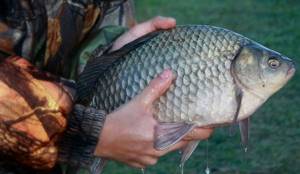
When the fish has accumulated a sufficient amount of eggs, its spawning will begin - individuals of both sexes gather in a dense cluster of thickets, mainly in the first half of the day. Females begin to spawn in 4-5 rounds. This is where the first clutch begins.
During each spawning session, the female produces about 100-150 thousand eggs, but the bulk of them die, they are devoured by other predator fish, and only a third survive. If the spring is cold, spawning will begin much later. The end of spawning occurs in mid-June, but may end earlier. The interval between spawning for crucian carp is up to 14 days.
Each female must have time to spawn at least 3 times, so this process sometimes drags on until the beginning of July. Although the bulk manages to spawn until mid-June.
Time to catch crucian carp
You can start fishing for crucian carp in April. The stability of its bite is guaranteed in cold water, before the start of spawning.
The main points at which crucian carp bite occurs:
- maintaining the temperature in the reservoir at about 10 0C for 6-7 days
- muddy bottom of a reservoir.
But since crucian carp is not a very predictable fish, it was noticed that the best time for crucian carp fishing would be an hour before sunrise and a couple of hours before morning, approximately until 8 am. Further, if the weather permits, the crucian bite will last all day and end after the sun sets. But still, in the spring, daytime bite is very rare. Towards evening the bite may resume.
Air temperature
And if the air temperature continues to reach 150C for ten days, the period comes when crucian carp begins to be caught in the spring. If it suddenly gets significantly colder again, he stops pecking until it gets warm again.
Wind
The influence of wind direction is also undeniable when fishing for crucian carp.
Crucian carp bite better if the wind direction is:
- southern.
- Western.
Crucian carp loses its activity in winds:
- northern
- eastern
Wind speed aggravates the behavior of fish in accordance with the direction of its movement. That is, if the wind is south and its strength increases, then the crucian bite will intensify. And vice versa. If the east wind increases, crucian carp activity fades.
Cloudiness
A good spring bite for crucian carp is noted during sunny and clear days, when the sun warms up the water near the shores of reservoirs.
In the event of rain or thunderstorms, the crucian carp calms down and its biting stops, as the atmospheric pressure begins to fluctuate. This negatively affects this type of fish. As soon as the weather stabilizes, the bite resumes.
Factors influencing the bite
A fisherman can, at least partially, predict the upcoming fishing trip himself. It is necessary to take into account and compare certain factors, for example: seasonality, atmospheric pressure, temperature, etc.
Season
Crucian carp is caught on a hook in different ways depending on the season:
- The first bites begin in March , when the ice begins to melt. April, May - different activity, they can only bite on bait of an animal nature. The most catchy places during the day are shallow water areas illuminated by the sun.
- The summer period for catching is considered the best, especially the first months: June, July. The spawning time has passed, so she is actively eating fat. Fishing areas need to be well fed.
- In autumn it is no longer so active ; in November it will not be easy to catch it.
- In winter, it lies in underwater holes and remains there until early spring , so bites will be sporadic, or there will be none at all.
Weather
Weather conditions affect bites:
- During light rainfall, the bite intensifies. Because the water is enriched with oxygen, so the fish comes to life. Rain washes away various insects from trees and bushes, they fall into the water, and this is a real delicacy for crucian carp.
- If it is very hot and sunny, all the fish hide in the depths and are poorly caught.
- When there is a lot of cloudiness, a good bite begins.
- A weak wind will favor the fisherman, while a strong and gusty wind will, on the contrary, reduce bites.
Catch time
Best catch time:
- morning hours, at dawn;
- evening time;
- in the summer after sunset.
Atmosphere pressure
Crucian carp bite well: with decreasing and stable pressure. A decrease indicates changes in the weather, and for the worse; a cyclone comes and brings with it: wind, precipitation. The crucian carp senses this well, so the bite becomes more active. If the jump is too sharp in any direction, the bites become infrequent or stop altogether.
This is tied to its structure; the bubble imparts neutral buoyancy, which is why it can be calm and stable at any depth. But when the pressure drops or rises sharply, the bubble can no longer fulfill its natural function, and the fish loses its orientation.
Stable pressure - 750 mm r. With.
Temperature
The activity and vital functions of the fish will depend on the water temperature. They are cold-blooded, which means their body temperature will increase only due to the increase in water temperature.
Each species has its own comfortable temperature conditions. Within these limits she feels most comfortable. But if the temperature drops or rises significantly, crucian carp immediately lose their appetite and become apathetic. The best temperature is 12-19ºС.
Place of catch
- where the water is covered with egg capsules, water lilies and lilies;
- optimal depth: 2-4 m;
- near trees that have fallen into the water, in the reeds;
- under cliffs, sloping banks.
Tackle used
Crucian carp is caught with different gear, it all depends on the season and the characteristics of the reservoir:
- fly rod (blind rig);
- tackle for distant casting: with a sliding float and a reel (“running tackle”);
- donka;
- donk equipped with a rubber shock absorber;
- feeder.
Bait
Choosing the right bait is not easy - it’s an art, let’s figure it out.
- In winter, for example, crucian carp prefers bait of animal origin because it is more nutritious.
- In the spring, during the pre-spawning feast (April, May), hungry for the winter, they grab everything. But it’s better to focus on “living creatures”. This lasts 2 weeks, don't miss this time.
- In summer, on hot days, it bites more readily on plant baits.
- During the fall months, offer him animals.
Features of fishing for crucian carp
Fishing for crucian carp involves taking into account a wide range of aspects, but the most important are:
- Fishing place.
- Time and seasonality.
- Bait and groundbait.
- Tackle.
Let's look at these points in more detail.
Where to fish?
It's no secret that the success of the fishing itself largely depends on the choice of fishing location. That is why its selection should be approached with appropriate attention. Crucian carp is a common fish species that is present in many reservoirs, so finding a place on the river where crucian carp will bite is not so difficult.
When choosing, you should take into account the presence of reeds, depressions, and holes in the reservoir. The fact is that there is a food supply for fish there, and also in the summer there is cooler water, which the fish like. So the place where there is a higher probability of meeting crucian carp will be a shallow backwater with reeds.
Let's celebrate! If you have a usual fishing spot near your home, you can feed it in advance. Crucian carp is quite picky in food, so cake, wheat, and special bait, which can be purchased in fishing stores, are suitable for complementary feeding.
Pre-feeding will attract many fish, which can increase your chances of a successful catch.
Seasonality
Of course, how the crucian carp will bite largely depends on the time of year. Each season of the year is distinguished by its fish activity:
- Spring. This is the time of fish spawning. Accordingly, before spawning, the zhor begins, which continues for quite a long time and ends some time after the completion of spawning. Many fishermen note that spring is the most suitable time for catching crucian carp, because you can catch quite a lot of it.
- In the summer, crucian carp becomes more capricious and selective. This is explained by the fact that there is quite a lot of plant food around him. As a result, it is really difficult to please this fish. That is why fishermen use various baits from cereals, dough, semolina and much more. In the summer, crucian carp approach the food base in the morning, in the evenings and at night, so the optimal time for fishing will be early morning and evening.
- In autumn , due to the colder weather, the bite becomes a little worse. Schools of crucian carp do not appear near the coast so often, preferring deeper places, and again switch to animal food. With the arrival of cold weather, the bite gets worse every day, so it becomes more difficult to catch it. Fishermen choose casting rods, feeders, and float tackle with long casting for fishing. The most suitable baits are animal baits – dung worm, maggot, bloodworm.
- Many fishermen are sure that in winter, crucian carp completely burrow into the silt and spend all three months there. But this rule does not work everywhere and not always. So, for example, in deep reservoirs, crucian carp continues to feed in winter, so catching it in winter is quite possible. At this time, it is located in places with warmer water. Fishing is done with bloodworms and jigs, but one should not forget about bait.
Times of Day
As noted above, the time to catch crucian carp largely depends on the season. So, in the summer, it becomes most active by 5 o’clock in the evening, but at the same time, crucian carp also shows itself well early in the morning and in the evening, etc.
However, it should be understood that the conditions of a particular reservoir and weather also influence the bite time. For example, in cloudy weather with low air temperatures, the bite can be active throughout the day. But as a rule, fishermen go fishing mainly in the morning.
What can influence the bite?
To summarize this part, I would like to note that all of the above factors influence the bite in one way or another, as a result of which, when going fishing, you should take them all into account. You also need to choose the right baits and fishing gear themselves.
After all, even if the conditions are most suitable for catching crucian carp, it will be quite difficult to catch it without appropriate preparation.
Tackle for catching crucian carp: equipment
The gear needs to be simple, but inconspicuous. Because crucian carp is shy and, if it suspects something, it will not approach, but, on the contrary, quickly retreats a good hundred meters. The simplest, but most effective for small things is a float rod. They catch bigger fish with a donk.
Float rod
The float rod is the most popular tackle; there are two types of float equipment:
- Fly fishing rod with a length of 4-6 m without a reel, with blind equipment and 2 gr. sensitive float. Can be cast up to 11 m.
- The fishing rod is equipped with: reel, float, it will easy to slide along the fishing line to the rubber stop, it is installed at a certain distance from the hook. The casting distance will depend on the quality of the tackle and the skill of the fisherman:
- The lighter the tube float, the better.
- The main line is blue-green, but it can also be colorless. For small fish - 0.12-0.16 mm, large fish - 0.2-0.25 mm. The leash is up to 20 cm long, 0.1 mm thick.
- Hook No. 5-7, the length of the fore-end is no longer than the width of the bend.
- Sinker-pellet.
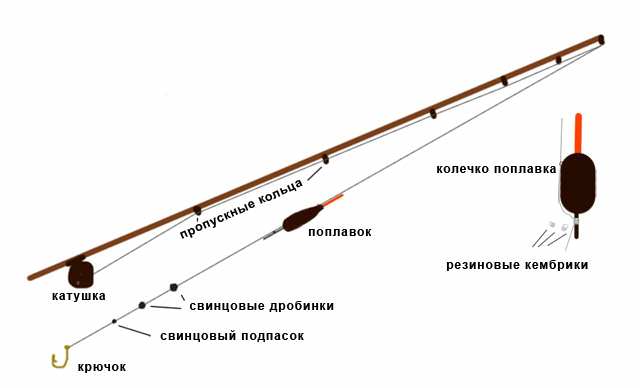
Float fishing rod (blind equipment)
Donka
A bottom fishing rod, unlike a float rod, can be cast over longer distances and used in deep-sea reservoirs.
The donka consists of: a fishing line, a corresponding load, leashes with hooks; for the donka they take a braided thread, it is better than a fishing line:
- for small things, up to 250 gr. — Ø 0.06 mm;
- larger fish, up to 500 gr. — Ø 0.1 mm;
- trophy - Ø 0.12 mm.
You can use monofilament:
- fines - Ø 0.13 mm;
- up to 500 gr. — Ø 0.2 mm;
- 1 kg and more - Ø 0.25 mm.
Leashes should be thinner than fishing line, no longer than half a meter. The sinker can have any shape: triangular, oval, flat, etc.
There are several types of donks:
- Donka-elastic band differs from other donkas only in the presence of an elastic band.
- Donka with various feeders will help you feed the area and catch big fish.
- Donka-zakidushka - fishermen collect it themselves from available gear.
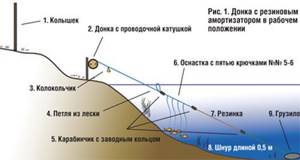
Donka-elastic band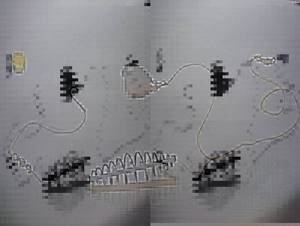
Donka with a feeder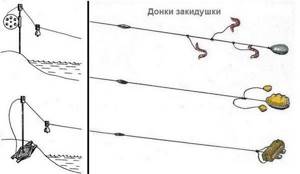
Donkey-tricks
When does the crucian bite start in spring?
“ When does crucian carp start biting in the spring? "
Here the answer is simple - starting in March you can go fishing. However, it should be remembered that crucian carp inhabits various aquatic ecosystems: natural and artificial ponds and reservoirs, lakes, rivers, it can even be found in swamps; In each water, the behavior style of crucian carp will be different. Wait until early April. During this period, the weekly water temperature will reach 11-12 degrees. Choose a calm, sunny day.
Spring crucian carp should be caught in shallow lakes or ponds with a wide shallow area. The fish is in shallow water warmed by the sun, trying to stay close to old reeds and grass. Usually the depth of these places does not exceed a meter. Take a closer look at the snags, littered with branches - crucian carp will probably also notice such places.
Crucian carp is a cautious fish, especially in the spring, so you shouldn’t wait for a bite right away. Spring, pre-spawning, crucian carp is active, so get ready for active fishing and moving along the shore. We advise you to find and feed not one, but 3-4 fishing spots, at a distance of 25-30 meters from each other. This will help track the movement of crucian carp through the reservoir; after winter, the fish walk in the heated upper layers of water and do not stay in one place, as they are deprived of natural food - algae and fresh bottom vegetation. So much the better for the fisherman - the crucian carp will not be picky and will happily bite on the offered bait. However, we recommend using animal bait during the pre-spawning season. For crucian carp, they are more nutritious, unlike vegetable ones, therefore, the fish will give preference to maggots or bloodworms rather than dough or cereals.
For spring fishing for crucian carp, a fly rod 5 to 7 meters long is perfect. The choice of length is based on different fishing conditions, often associated with the need to search for crucian carp: casts are made either closer or further from the shore. The increased length of the rod will help you cast along the shore if you cannot get to the intended place unnoticed by the fish. In calm weather, the length of the fishing line is equal to the length of the rod; in light winds, the fishing line is shortened by 50-70 cm, thereby making casting easier.
Watch a video on spring fishing for crucian carp with a float:
At the beginning of spring, when the water is still cool, crucian carp reacts to a moving bait, so the equipment is made lightweight, transmitting vibrations of the wind or current. Floats - weighing up to a gram, with an elongated body and a long colored antenna. In the spring, the crucian carp swallows the bait greedily, with a rise; Such equipment will not leave you in the dark.
Best lures
You need to select and prepare the bait correctly, you need to take into account: the characteristics of the reservoir, the weather.
Don’t be afraid to experiment, offer different baits one by one until you settle on one.
Animal origin
- crawlings (worms, up to 35 cm);
- dung, earthworms and earthworms;
- maggots - fly larvae;
- bloodworms, bark beetle larvae, cockchafer;
- various winged mayflies.

Crawling out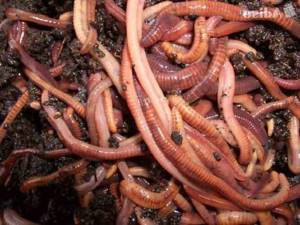
Dung worms
Maggot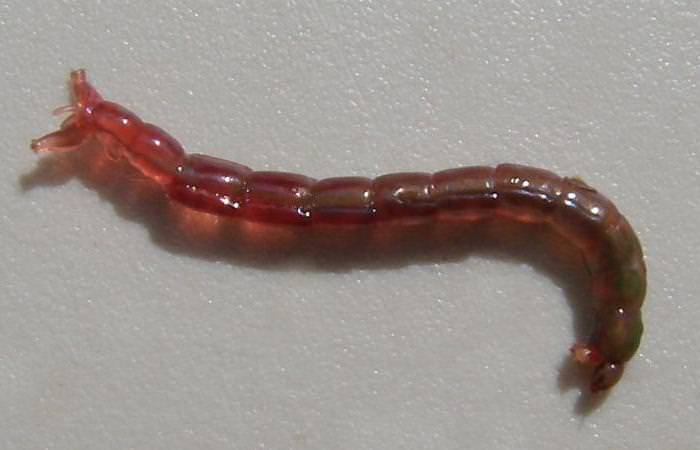
Bloodworm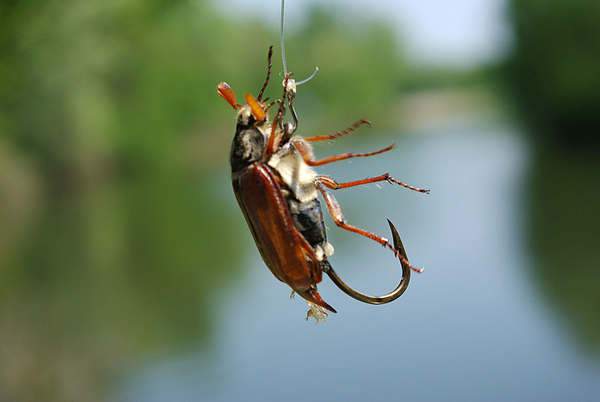
Chafer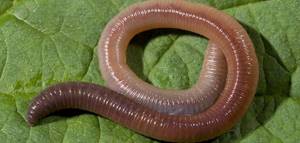
Earthworm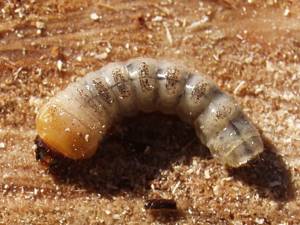
Bark beetle larva
Baits are used separately, but you can also make a sandwich; it can work faster and more efficiently.
Vegetable origin
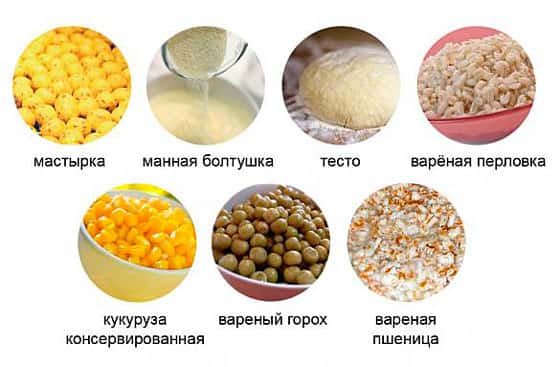
Plant baits for crucian carp
Various grains and legumes, they are boiled, steamed in a thermos, or infused in boiling water: barley, corn, wheat , etc.
- Knead the dough from flour. They make mastyrka, mash from semolina, brew thick porridge, prepare protein dough from dry store-bought mixtures, add various flavorings and store-bought aromas.
- Canned corn, peas.
- They cook porridge from oatmeal, hominy, etc.
- Boilies.
Bait selection
Baits include:
- Bloodworm. Used for fishing with a regular fishing rod. Bloodworms are not suitable for long-distance fishing.
- Maggot. Suitable for match and regular fishing. Maggot is considered the favorite food for almost all fish, and if the task is to catch only crucian carp, you will have to try, since other fish can drive the crucian carp away from the biting place.
- Worm. The most accessible and popular bait, especially in the spring. In summer, crucian carp are reluctant to take worms, preferring plant bait.
Popular attachments
Baits include bait of plant origin. They are best used for summer fishing.
Popular baits among fishermen include:
- Pearl barley. To attract fish, it is recommended to roll pearl barley in breading or in a strawberry or bloodworm flavor before casting.
- Sweet corn. You can catch a large specimen with it. Corn grains hold tightly to the hook, therefore, you can fish with such a bait even in the current.
- Dough. It is used when crucian carp does not take any of the proposed baits. When casting over long distances it is not suitable, but at short distances it works very effectively.
Reasons for lack of bite
There are a lot of factors that will directly or indirectly influence the lack of bite. The most common reasons:
- adverse weather conditions;
- the beginning and end of spawning;
- incorrectly selected gear;
- improper feeding;
- mistakes in choosing bait;
- time and place chosen incorrectly.
Cloudy and cold water
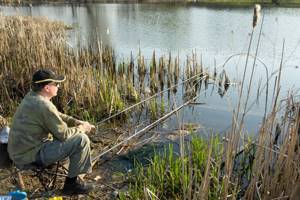
It happens only after the ice melts that there is very little food, so catching large fish at this time is not difficult. Use a 3-4 m float rod, line Ø 0.12-0.15 mm, light equipment, make the float heavier, set the load, focusing on the weight of the bait, and begin the hunt.
They lower the bait, then quietly move it a little to the side and grab it immediately. If you guess the bait correctly, you will go home with your catch. When it snows, and this is not uncommon in spring, fish can hide: in depressions on the bottom or near last year’s coastal or aquatic vegetation.
Thick line
Thick fishing line is intimidating, for several reasons:
- Crucian carp distinguishes colors well, this is a proven fact, which means that an unnatural color will involuntarily scare away.
- He sees in the dark, but distinguishes well only those objects that are no closer than 2 m from him. At a distance of 10-15 m he does not distinguish anything, he is oriented only by light. This means that the fishing line that reflects light is comparable to a burning lamp: the light conductivity of synthetics, the reflection of rays from above.
- Recognizes the size - is frightened by the length of the fishing line, it is larger than itself.
To avoid fear, it is advisable to camouflage the fishing line, this will break up the color scheme. Paint it in different colors, every 4-7 cm. This way the fishing line will be perceived as separate objects, and they will now be smaller than itself, which means there will be no fear.
Place
There can be many reasons for the lack of bites in the chosen place:
- Relocation - Find another location.
- Weather conditions - if the heat is unbearable, you should look for fish in the shade at depth; if, on the contrary, the water is not warmed up, look in shallow water, in areas heated by the sun.
- Favorite places : overgrown with vegetation and snags; it is not easy to reach, but it feels safe there.
- The diameter of the fishing line and leader does not correspond to the fishing conditions : for example, the water is too clear and the fishing line is thick.
- Does not correspond to fishing conditions : hook size, bait, its color, sinker weight.
Techniques and tactics of catching crucian carp
- We begin the search for a future fishing spot - the optimal distance is 1-2 m or less.
- We determine the depth - make the distance from the hook to the float - 1 m. We cast, the float has moved to a perpendicular position, which means the place is too deep. Adjust the float.
- Large crucian carp come close to the shore only at dawn or in the evening, keep this in mind. Do not feed in large portions; add little by little, and only the bait that you will use. The bite has appeared, little by little you can throw it in to keep the fish in place.
- Crucian carp prefers stagnant bodies of water, so it hunts better in creeks, creeks, and forest lakes.
At what pressure does crucian carp bite best?
Another significant factor on fish biting is considered to be the indicator of atmospheric pressure, in particular its changes:
- Fish reacts quite sensitively to even minor pressure surges , this is due to the dependence of internal pressure in the swim bladder with external pressure indicators and pressure in the water column. Biting activity decreases.
- A sharp increase in atmospheric pressure forces the aquatic inhabitant to rise to the upper layers of the reservoir ; even his favorite baits (worms, maggots) are not attracted to him. This period of time is characterized as a sleepy state of crucian carp, from which nothing can be taken out. With the normalization of pressure indicators, the condition of the crucian carp also returns to normal.
Taking into account the structural features of the fish’s body, with a sharp change in atmospheric pressure, it experiences problems in spatial orientation. She does not understand at what depth she is and what is the distance to objects.
The answer to this question is located in the main sense organ of an aquatic inhabitant, in its lateral line, where when external pressure changes, the same failure occurs. It is for this reason that she is unable to find the bait offered by the fisherman; this state can be compared to the intoxication of a person. Hence the poor catch rates.
- With reduced pressure, the fished object, on the contrary, descends to depth, and bites decrease. It can only be caught using bottom gear.
Tips and tricks
The most productive hunt will be:
- After prolonged bad weather, changes came and the weather returned to normal.
- On warm, windless, but cloudy days.
- After a long drought, a long period of rain begins.
- Before a thunderstorm, drizzling rain, small ripples.
- In clear, sunny weather, with a southerly wind direction.
The area must be fed in advance with ready-made bait mixtures, porridge, spoiled cottage cheese, etc. At night, it is better not to use floats with shiny inclusions. You need to fish it out quickly so that if it resists, it doesn’t fall off the hook!
